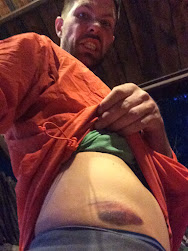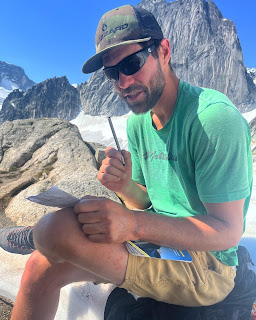Can you be active after heart surgery and while taking an anticoagulant?
This question loomed over me for months before surgery. Here is what I have learned in the years since.
 |
| A photo of me in Washington Pass about two years after surgery |
Heart surgery undoubtedly changes a person's life. In 2016, when being rolled into the operating room to replace a faulty Aortic Valve, I did not know the extent of this change. A few people told me stories of what it was like to live with a mechanical valve. The main focus of my interest in these stories was to learn what it would be like to live life on "blood thinners" (anticoagulants), since this was one of my biggest concerns about choosing a mechanical heart valve. The issue, though, was that the people I talked to did not live their life similar to the way I want to live mine, so their antidotes were not fully helpful.
 |
| Sometime bruises 'appear' after a long day of climbing. |
They had "normal" lives, where risk is not part of the day-to-day experience. Sure, some of the people I talked to were avid hikers, bikers, educators, parents, etc., but they were not putting themselves into risky situations or in places where small cuts were inevitable. For a normal day-to-day experience, things like doing dishes and walking with bare feet are what cause stress, since simple activities like this can result in small cuts, and therefore must be done with caution. I had to dig deeper to find what I was looking for.
My interest stemmed from the fact that I am always working to be a decent rock climber. This means that there was no true blueprint to what life would look like on Warfarin. I have yet to meet another avid climber with a mechanical heart valve or who takes anticoagulants, so I had to create my own roadmap.
 |
| A photos of me on a 23 hour climb of Half Dome in Yosemite, 2 years after heart surgery |
After surgery, my anticoagulation level, or INR (international normalized ratio), was a bit concerning. It takes a few days for Warfarin to accumulate and stabilize in a person's system, and my INR was all over the charts. At one point, my INR was above 4, when my goal range is between 1.5 and 2. This basically means that I would bleed twice as much as I was supposed to, if I got a cut or internal bleed. I was afraid and thought the worst: I would never be able to safely do the activities that I loved again. I started to think that rock climbing would be foolish and that any activity where I was not sitting safely in a bubble in my living room would be unattainable.
"Just because I was on anticoagulants did not mean I had more of a chance of getting cut. Anticoagulants meant that if I did get cut, I would need to work faster to stop bleeding."
Luckily, my INR stabilized over time (2-3 weeks). I got within range, kept my diet consistent, and slowly started to think about doing the activities I love. After my 5 week check up, I was cleared by my doctor to resume all activity, but to stop if I felt discomfort. He said I should wear a helmet when doing extreme activities (climbing, biking, kayaking, etc.), but otherwise that I should live my life a I hoped to. It was time to transition back to my passions!
 |
| Here is a photo of me leading the "Great Roof," about 2000' up El Cap. |
 |
| My hands after spending 23 hours climbing Half Dome's NW Face |
So, in the four and a half years since surgery, what have I learned? Can a person be active after heart surgery and while taking anticoagulants?
In short, yes. The most important thing is to check with your doctor. Make sure your doctor knows the activities you are interested in and have an in-depth conversation. If they tell you that you are not allowed to do activities you love, don't be afraid to ask "why," but always follow their plan.

Here is a photo of us waking up after day #1 on "The Nose". Pretty cool spot.
If a doctor does approve you for activity, start small. The biggest thing holding me back from climbing after surgery was my brain. My doctor approved me for all activities with my new mechanical aortic valve, but that did not mean I was ready. I had to start small, often re-climbing routes that were very easy for me. I had to remind myself of my capabilities before getting back into the realm of hard climbing.

Since recovering, I have nothing holding me back. I have climbed Half Dome (Yosemite via the "NW Face"), El Capitan (Yosemite via "The Nose"), Timewave Zero (2300' sport cimb in Mexico) and many other long routes. I am also pushing into harder technical climbs that I was doing before surgery. In addition to climbing, I surf (a very little bit), ski (a lot), ride my bike, and do any other activity without restriction.
A short video of me climbing an 11c (R rated) rute in Eldorado Canyon, Colorado

Comments
Post a Comment